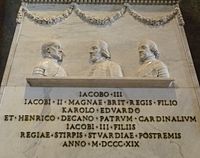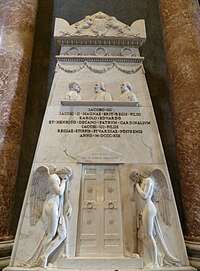Jacobite succession
The Jacobite succession is the line through which Jacobites believed that the crowns of England, Scotland, and Ireland should have descended, applying primogeniture, since the deposition of James II and VII in 1688 and his death in 1701. It is in opposition to the legal line of succession to the British throne since that time.
Excluded from the succession by law because of their
When Henry died childless, the Jacobite claim was then notionally inherited by Henry's nearest relative (a second cousin, twice removed), and then passed through a number of European royal families. Although the line of succession can continue to be traced, none of these subsequent heirs ever claimed the British throne, or the crowns of England, Scotland, or Ireland. A spokesman for the current heir,
History
Background: the Glorious Revolution and Hanoverian succession
William and Mary were succeeded by James's younger daughter and Mary's sister,
Stuart claims in exile
James II and VII, his son, James, the 'Old Pretender', and his grandsons, Charles, the 'Young Pretender' and Henry, called Cardinal Duke of York, never accepted the loss of their crowns and continued to press their claims from exile to varying degrees.[13] They were supported by Jacobites in England, Ireland, and, particularly, in Scotland.[14][a] The Jacobite succession, as a dynastic alternative for the throne, became a major factor in destabilising British politics between 1689 and 1746.[15] Jacobitism was perceived by contemporaries to be a significant military and political threat,[16] with invasions and uprisings in support of the exiled Stuarts occurring in 1689, 1715, 1719 and 1745.[14]
Internationally, the Jacobite succession had limited recognition. Only
With the defeat at the Battle of Culloden in 1746, Jacobitism was dealt a death blow and the Jacobite succession lost its significance as a dynastic alternative to the Hanoverians.[22] Jacobitism went into a rapid decline and with the death of Charles, the 'Young Pretender' in 1788, the Jacobite succession lost what was left of its political importance.[23] His younger brother, Henry, Cardinal of York, died in 1807 and the Royal House of Stuart thereby became extinct.[24] With the death of the last Stuart, the House of Hanover was completely established as the only credible dynasty for the British throne.[25]
Line of succession after the Stuarts
Applying
Pretenders and subsequent heirs
English
Stuart pretenders
The Stuarts who claimed the thrones of England, Scotland, and Ireland as pretenders after 1688 were:
| Claimant, lifespan and dates of claim | Portrait | Basis of claim |
|---|---|---|
| James II & VII (1633–1701) 11 December 1688[b] – 16 September 1701[2] |
 |
James lawfully succeeded his brother, Charles II, to the throne on 6 February 1685, as Charles did not have any legitimate children.[41][42] When James fled the country in 1688, the English Parliament declared that he had abdicated[2] and the Scottish Convention of Estates declared he had forfeited his crown.[4] However, James and his supporters denied that he had abdicated[3] and claimed that the declaration of forfeiture had been by an illegal Scottish Convention.[38] They maintained that James continued to be the rightful king.[43] |
| James Francis Edward Stuart (1688–1766) ("James III & VIII")[13][44] ("The Old Pretender") 16 September 1701 – 1 January 1766[13] |
 |
Upon James II & VII's death in 1701, James, called the Old Pretender by his detractors, as James II/VII's only surviving legitimate son,[45] inherited his father's claim.[46] |
| Charles Edward Stuart (1720–1788) ("Charles III")[13][44] ("The Young Pretender") ("Bonnie Prince Charlie") 1 January 1766 – 31 January 1788[47] |
 |
Upon the death of James, the "Old Pretender", in 1766, Charles, as James's eldest son, assumed his claim to the throne.[47] |
| Henry Benedict Stuart (1725–1807) ("Henry IX & I")[44][48] ("Cardinal Duke of York") 31 January 1788 – 13 July 1807[49] |
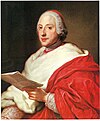 |
Henry used the title of Duke of York that his father bestowed on him. Upon Charles Edward Stuart's death in 1788, Henry, as Charles's only brother, was the last surviving legitimate descendant of James II/VII.[49] The Pope did not recognise his claim to the British throne. |
Subsequent succession
Upon the extinction of the Royal Stuart line with the death of Henry, Cardinal of York, and applying male-preference primogeniture unaltered by the Act of Settlement 1701, the succession would have passed to the individuals named in the table below. However, unlike the Stuart pretenders, none of them has claimed the British throne (or the thrones of England, Scotland or Ireland) or incorporated the arms of these countries in their coats-of-arms.[26] Nevertheless, since the 19th century, there have been small groups advocating the restoration of the Jacobite succession to the throne.[30][50][51]
| House | Descendant, lifespan and dates as heir-general of the Stuart pretenders[c] | Portrait | Relationship to predecessor in line of succession (primogeniture) | |
|---|---|---|---|---|
| Savoy |  |
Senior surviving descendant of Henry Cardinal of York's great aunt, Henrietta of Orleans, who was the youngest sister of James II/VII.[54][55] Henry had died childless and no other legitimate descendants of James II/VII survived.[49][55] As at Henry's death, there were no surviving siblings of James II/VII or their legitimate descendants, except the descendants of Henrietta.[55] | ||
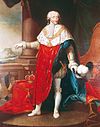 |
Next eldest brother of his predecessor, Charles Emmanuel, who had died childless.[56] | |||
| Maria Beatrice of Savoy (1792–1840) ("Mary II"[52] or "Mary III"[57])[d] 10 January 1824 – 15 September 1840[58] |
 |
Eldest surviving daughter of her predecessor, Victor Emmanuel, who had no surviving sons.[59] | ||
| Austria-Este | Francis V, Duke of Modena (1819–1875) ("Francis I")[52][57] 15 September 1840 – 20 November 1875[60] |
 |
Eldest son of his predecessor, Maria Beatrice.[61] | |
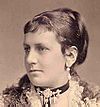 |
Niece of her predecessor, Francis, who died childless. She was the only child of Francis's only brother, Ferdinand, who had pre-deceased Francis.[56][63] | |||
Wittelsbach |
Rupprecht, Crown Prince of Bavaria (1869–1955) ("Robert I & IV")[52] 3 February 1919 – 2 August 1955[64] |
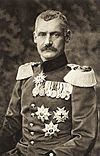 |
Eldest son of his predecessor, Maria Theresa.[65] | |
| Albrecht, Duke of Bavaria (1905–1996) ("Albert")[51] 2 August 1955 – 8 July 1996[66] |
 |
Eldest surviving son of his predecessor, Rupprecht.[67] | ||
8 July 1996 – present |
 |
Eldest son of his predecessor, Albrecht.[67][68] |
- The Prince Max, Duke in Bavaria(born 1937).
- Prince Max's heir presumptive would be his eldest daughter Sophie, Hereditary Princess of Liechtenstein (born 1967)
- The next heir-in-line would be her eldest son Prince Joseph Wenzel of Liechtenstein (born 1995) of the House of Liechtenstein.[68]
- Prince Max's heir presumptive would be his eldest daughter Sophie, Hereditary Princess of Liechtenstein (born 1967)
Family tree
| Family tree showing the Jacobite line of succession and its relationship to the UK monarchs descended from Sophia of Hanover |

|
See also
- Alternative successions to the English and British Crown
- Jacobite consorts
- Jacobo Fitz-James Stuart, 17th Duke of Alba
Notes
- ^ Their supporters traditionally toasted the pretenders as "The King over the Water".
- ^ The date given for the commencement of his claim is the date upon which James fled London.[39] The English Parliament deemed that his flight constituted his abdication from the throne[2] by a declaration made on 28 January 1689.[39] With regard to the Scottish throne, however, James was not deposed until 4 April 1689, when the Scottish Convention of Estates declared that he had forfeited the crown.[40] His Scottish deposition was not linked to his flight on 11 December 1688, but to his misdemeanours generally.[4]
- male-preference primogeniture. The dates given are the dates of the death of the individual’s predecessor in the line of succession and their own death.
- ^ a b Terry (1901) numbers Mary, Queen of Scots, as Mary II (considering her the rightful queen after Mary I of England) whereas Petrie (1950) does not.
References
- Daily Telegraph. Archived from the originalon 17 June 2008. Retrieved 22 June 2008.
- ^ a b c d e f "James II". BBC History. Retrieved 13 October 2019.
- ^ ISBN 978-1-4094-7973-4.
- ^ ISBN 978-0-85411-058-2.
- ISBN 978-1-84383-939-2.
- ^ a b c Richard Cavendish (2001). "The Act of Settlement". History Today. 51 (6). Retrieved 16 October 2019.
- ISBN 978-0-7509-4577-6.
- ISBN 978-1-139-46187-0.
- ISBN 978-0-00-720376-5.
- ISBN 978-0-7486-2876-6.
- ISBN 978-0-19-166760-2.
- ^ "Research Briefings: RP 99-17 The Act of Settlement". The Scottish Parliament. 14 December 1999. Retrieved 19 October 2019.
- ^ a b c d “James Edward, the Old Pretender | Claimant to the English and Scottish thrones”, “Charles Edward, the Young Pretender | British prince” "Henry Stuart, cardinal duke of York | British pretender". Encyclopedia Britannica. 2 March 2024.
- ^ a b "The Jacobite Cause". BBC History. Retrieved 17 October 2019.
- ISBN 978-0-521-57498-3.
- ISBN 978-1-349-26908-2.
- ISBN 978-0-521-58462-3.
- ISBN 978-0-521-51327-2.
- ISBN 978-1-317-89426-1.
- ]
- ISBN 978-0-521-44793-5.
- ISBN 978-0-230-51888-9.
- ISBN 978-0-521-44793-5.
- ISBN 978-0-19-880396-6.
- ISBN 978-1-317-02932-8.
- ^ a b c Charles Petrie (1950). The Jacobite Movement (Vol. 2). Eyre & Spottiswoode. p. 194.
- ^ James Cooray Smith (16 May 2016). "Lines of duty: Tales of the Jacobites, and other alternative successions". New Statesman. Retrieved 16 October 2019.
- ISBN 978-1-78885-307-1.
- ISBN 978-1-317-60526-3.
- ^ a b c Justin Huggler (17 September 2014). "Could the Duke of Bavaria be the next King of Scotland?". Daily Telegraph. Retrieved 23 August 2016.
- ISBN 978-0-7190-3774-0.
- ^ "Jacobite uprising: 'To us, 1745 doesn't feel that long ago; in evolutionary terms it's nothing'". The Scotsman. 21 August 2009. Retrieved 28 April 2022.
- ^ ISBN 978-0-8108-7497-8.
- ^ ISBN 978-0-19-829334-7.
- ISBN 978-0-414-00912-7.
- ISBN 9781862320901.
- ISBN 978-0-521-13794-2.
- ^ JSTOR 4048254.
- ^ ISBN 978-0-582-77256-4.
- ISBN 978-1-84383-939-2.
- ISBN 1-134-75547-3.
- ^ John Baptiste Wolf (1970). Toward a European balance of power, 1620-1715. Rand McNally. p. 92.
- ]
- ^ ISBN 978-1-85285-581-9.
- ISBN 978-0-7190-3774-0.
- ISBN 978-1-107-04133-2.
- ^ doi:10.1093/ref:odnb/5145. (Subscription or UK public library membershiprequired.)
- ISBN 978-0-567-00526-7.
- ^ a b c "Henry Stuart, cardinal duke of York | British pretender". Encyclopedia Britannica. 2 March 2024.
- ISBN 978-1-107-65873-8.
- ^ a b James Cusick (4 June 1995). "Bavarians, a bed-sit and the throne of Scotland". The Independent. Retrieved 2 November 2019.
- ^ a b c d e f Charles Petrie (1950). The Jacobite Movement (Vol. 2). Eyre & Spottiswoode. pp. 187, 194.
- ^ ISBN 978-0-88162-364-2.
- ^ Charles Petrie (1950). The Jacobite Movement (Vol. 2). Eyre & Spottiswoode. p. 183.
- ^ a b c Robert F. J. Parsons (1986). The Role of Jacobitism in the Modern World. p. 10.
- ^ JSTOR 30070199.
- ^ a b c Benjamin Stites Terry (1901). A History of England from the Earliest Times to the Death of Queen Victoria. Scott, Foresman. p. 805.
- ISBN 978-0-7876-4069-9.
- ^ Bernard Burke (1850). The Heraldic Register: 1849-1850 : with an Annotated Obituary. E. Churton. p. 6.
- ISBN 978-0-85935-009-9.
- ISBN 978-1-78885-307-1.
- ISBN 978-0-88162-364-2.
- ^ Robert F. J. Parsons (1986). The Role of Jacobitism in the Modern World. p. 13.
- ISBN 978-0-8153-3351-7.
- ^ "Obituaries: Princess Irmingard of Bavaria". The Telegraph. 8 November 2010. Retrieved 4 November 2019.
- ISBN 978-0-9532142-5-9.
- ^ a b Alan Cowell (11 July 1996). "Duke Albrecht Is Dead at 91; Pretender to Bavarian Throne". The New York Times. Retrieved 4 November 2019.
- ^ a b Giles Hattersley (16 October 2011). "Sorry, Wills, Franz gets the crown". The Sunday Times. Retrieved 6 November 2019.
External links
- Succession page Archived 7 March 2023 at the Wayback Machine of the website of the Royal Stuart Society.

